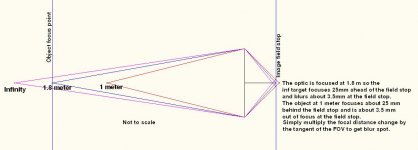hopefully I could understand it...

).
Hi Frank;
I will give it a shot, but may just make things worse.
DOF is an easy concept, optically, but not really easy to explain.
First thing to understand is the term diopter. This is a really scary word that means nothing more than a distance measurement, brought about for convenience.
With optics, as the distance from the observer gets greater the image gets smaller, so the diopter was used as a distance measurement so that as the distance increased the diopter got smaller in a specific proportion to the image size. Therefore the diopter is nothing more than the reciprocal of the distance, in meters (d=1/meters).
Now, this brings us to lens law and focus accommodation, and how diopter is used for simplicity. First a couple of examples with unaided eye:
Infinite distance = 0d
2 meters = 0.5d
0.5 meters = 2d
At this point we can see that the unaided eye, with about 2d of accommodation, will perceive everything from about 0.5 meter to infinity as in focus. Now notice that:
0.5 meter =2d
0.25 meter = 4d
So still a 2 diopter difference, which would appear in focus, all else out of focus. If we go the next 2 diopter:
0.25 meter =4d
0.167 meter = 6d
So now we can see how shorter focal lengths bring about a sharper range.
It can be shown that magnification is related to focal distance by the square of the power. If the 2 meter focus range for 1x is 0.5d then at 7x, 2 meter would be 24.5d (7x^2*0.5d), at 8x it would 32d, 10x =50d, etc.
A closer example of 2d DOF would be, if focused at 10 meters, the following ranges:
Power Close FAR DOF
1x 0.91 Inf Inf
6x 7.83 13.85 6.02
7x 8.31 12.56 4.26
8x 8.65 11.85 3.2
10x 9.09 11.11 2.02
30x 9.89 10.11 0.22
The above is assumed to be 2 diopter for illustration only. In the real world, if your vision has great accommodation then the optics would be the limiting factor, if your vision has less accommodation than the lens law factors, then your eyes would be the limiting factor.
The optics depth of field is measured on the optical axis and is the distance, in diopters, ahead and behind the focused object that remain in acceptable focus. This is most easily roughly checked by focusing on an object and checking out how far ahead and behind the object stays in focus
in the center or the field of view.
Things like field curvature, which makes things around the periphery, appear a diopter or two closer to you would make it seem you were looking at a 4 diopter DOF.
Astigmatism along the edge can make either horizontal or vertical objects appear a diopter or two closer or further away.
Focus speed has an effect. A binocular that focuses at 14 degrees per diopter can turn 28 degrees and maintain the same image as one that has a speed of 6 degrees/diopter that turns 12 degrees, thus seeming to have less DOF.
A lot of people also count 3d stereopsis as DOF, it is not.
DOF in the optics sense is only the distance ahead and behind the focused object, on axis, that remain acceptably sharp





